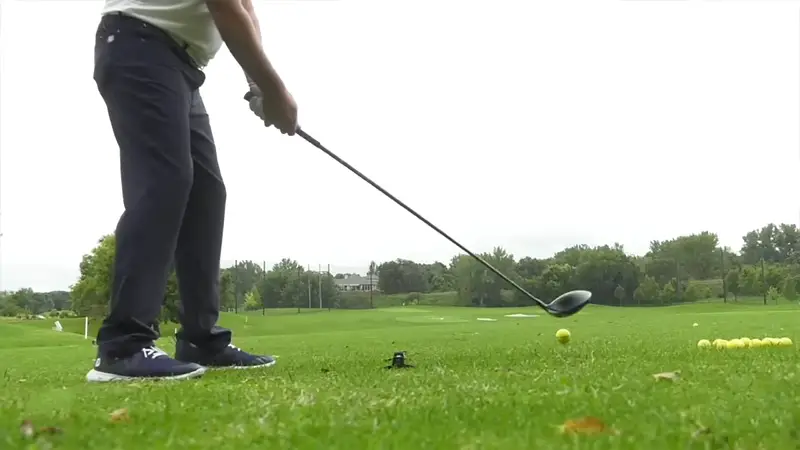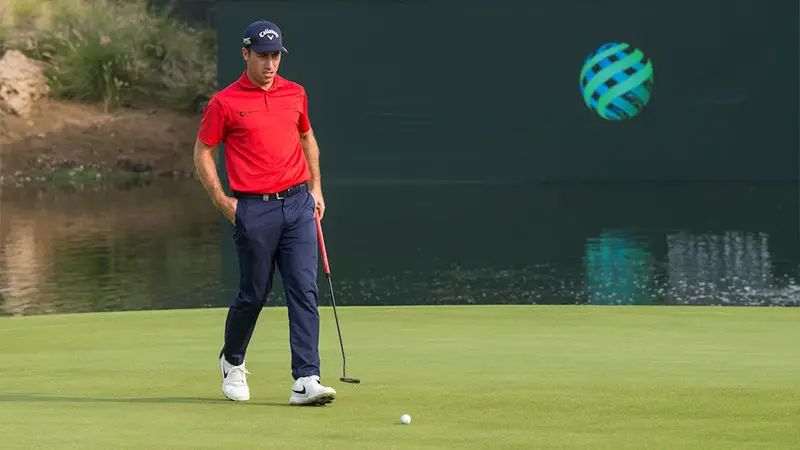Golf stances are the foundational starting points for every golf swing, playing a pivotal role in determining the quality and consistency of your shots.
These stances encompass a range of positions that influence balance, alignment, posture, and power generation throughout your swing.
From a wide array of shots – drives, iron shots, chips, and putts – to varying terrain and course conditions, different golf stances are tailored to suit specific situations.
Understanding the kinds of golf stances available, such as the basic neutral stance, open stance, and closed stance, empowers golfers to adapt their setups to the demands of the shot, ultimately enhancing their performance on the course.

What Is Golf Stance?
A golf stance is the foundational positioning of a golfer’s feet and body in relation to the ball and target. It encompasses the alignment, width, and orientation of the feet, as well as the distribution of weight.
A well-executed stance is crucial for stability, balance, and generating power during a golf swing. The most common stance is the neutral stance, with feet shoulder-width apart and toes slightly turned out.
Variations, like the open stance (for fades/slices) and closed stance (for draws), cater to specific shot shapes. Stance adjustments also accommodate terrain slopes.
Adjusting stances for uphill and downhill lies ensures consistent ball striking. Golfers refine their stance to suit individual style and shot requirements.
What Are the Kinds of Golf Stances?
In golf, the stance refers to the positioning of a golfer’s feet, body, and club in relation to the ball and the target. A proper stance is crucial for balance, control, and generating power during a golf swing.
There are several kinds of golf stances that players adopt, each catering to different shot types and situations.
Here are some of the main types of golf stances:
Neutral Stance
The neutral stance serves as the foundation for a wide range of shots. With feet shoulder-width apart and toes slightly turned out, golfers distribute their weight evenly between both feet.
This balanced setup allows for a comfortable and controlled swing motion. The neutral stance is the starting point for most shots, providing the golfer with a consistent platform to adapt to different shot requirements.
Open Stance
An open stance introduces a deliberate adjustment to the setup by positioning the lead foot back from the target line. This setup encourages the golfer to swing along an outside-to-in path, which can help create a fade or a slice.
Golfers might use an open stance to intentionally shape shots around obstacles or when dealing with challenging lies, such as when the ball is above the feet.
Closed Stance
In contrast to the open stance, a closed stance involves positioning the lead foot closer to the target line.
This stance promotes an inside-to-out swing path, which can lead to a draw shot. Golfers use the closed stance when they want to impart right-to-left spin on the ball.
It’s particularly effective for situations where they need to curve the ball around obstacles or when dealing with a ball below the feet.
Square Stance
The square stance is the most straightforward and versatile setup. Here, both feet are parallel to the target line, promoting a straight ball flight.
This stance is often used for pitches, chips, and putts that require accuracy and minimal deviation from the intended path.
It serves as a reference point for aligning the body to the target.
Wide Stance
For shots demanding power and distance, like tee shots and long fairway shots, a wide stance is effective.
Widening the stance beyond shoulder width provides a solid base for generating maximum clubhead speed.
This stance enables golfers to shift their weight and rotate their hips more dynamically, resulting in a longer swing arc and increased power.
Narrow Stance
When finesse and control are essential, as in chip shots and delicate putts, a narrow stance is employed. Bringing the feet closer together enhances stability and precision, allowing for a shorter and more controlled swing motion.
The narrow stance promotes a compact and controlled stroke, which is crucial for short-game shots.
High Ball Stance
On an upslope, where the ball is positioned above the golfer’s feet, a high ball stance is used. This stance involves adjusting the body’s alignment to match the slope, ensuring that the golfer maintains balance and control during the swing.
The slope can affect the angle of the clubhead at impact, so adapting the stance is essential for consistent ball striking.
Low Ball Stance
When addressing a ball below the golfer’s feet on a downslope, a low ball stance is necessary. Golfers bend their knees more and lean forward to maintain balance and a proper setup.
This stance accommodates the slope and helps prevent topping the ball or making poor contact due to the awkward lie.
How Do the Golf Stances Differ From Each Other?

Golf stances differ from each other primarily in terms of the positioning of the golfer’s feet, hips, and shoulders relative to the target line. These differences in stance have specific purposes that cater to various shot requirements and playing styles:
Square stance
This is the most common and neutral stance in golf. Your feet are parallel to the target line, and your shoulders, hips, and knees are aligned with your feet.
This stance is ideal for beginners, as it allows you to swing the club straight back and through without any adjustments.
A square stance is suitable for most shots, especially those that require accuracy and consistency.
Open stance
This is when your front foot is pulled back slightly from the target line, creating an angle between your feet and the target. Your shoulders, hips, and knees are still aligned with your feet.
This stance is used to create more power and distance, as it allows you to rotate your hips more and generate more clubhead speed. An open stance is also useful for hitting fades or slices, as it helps you swing the club from outside to inside.
Closed stance
This is when your front foot is pushed forward slightly toward the target line, creating an angle between your feet and the target. Your shoulders, hips, and knees are still aligned with your feet.
This stance is used to create more control and accuracy, as it allows you to swing the club straighter and prevent any unwanted hooks or draws. A closed stance is also helpful for hitting low shots or punches, as it helps you swing the club from inside to outside.
Precautions for Selecting Your Golf Stance

Selecting the right golf stance is essential for a successful swing, but it’s important to consider precautions to ensure your stance enhances your game.
Here are precautions to keep in mind when choosing your golf stance:
Avoid Overcomplicating
The abundance of stance options can lead to confusion. While it’s good to explore different stances, avoid overcomplicating matters. Striving for a stance that feels natural and doesn’t force your body into uncomfortable positions will contribute to a smoother, more consistent swing.
Stay Balanced
A balanced stance is the foundation of a successful golf swing. Avoid stances that make you feel unsteady or off-balance during your swing. Maintaining equilibrium allows you to execute the swing with control, leading to more accurate shots.
Consistency is Key
Continuity in your stance is vital for developing muscle memory and achieving consistent results. Constantly changing your stance can lead to erratic shots and hinder your progress. Once you find a stance that works, stick with it and refine it through practice.
Respect Your Flexibility
Your body’s flexibility and limitations play a significant role in your stance. Attempting a stance that your body can’t comfortably sustain might lead to strain and even injury. Adjust your stance to suit your body’s capabilities and avoid unnecessary stress.
Consider the Shot
Different shots demand different stances. Tailor your stance to suit the shot you’re attempting. Avoid using an extreme stance when it’s not necessary, as it could negatively affect your ball’s flight and consistency.
Avoid Extreme Adjustments
While minor adjustments can fine-tune your stance, extreme changes should be approached cautiously. Radical modifications like extremely open or closed stances can lead to inconsistency. Gradual adjustments allow you to assess their impact and make necessary refinements.
Don’t Neglect Comfort
Comfort directly affects your swing mechanics. An uncomfortable stance can lead to tension, disrupting your swing’s fluidity. Prioritize comfort to promote a relaxed swing, resulting in better clubhead speed and accuracy.
Professional Guidance
Seek guidance from a qualified golf instructor or coach. Their expertise can provide invaluable insights tailored to your unique swing and physique. This prevents you from adopting stances that might hinder your progress or even cause harm.
Practice and Adapt
Even after identifying an effective stance, continue to practice and make necessary adaptations. As your swing evolves and your body changes over time, minor stance adjustments might be required to maintain optimal performance.
FAQs
A golf stance is the setup position a player takes before swinging, affecting balance and control.
The primary types are Neutral Stance, Open Stance, and Closed Stance, each influencing shot shape and direction.
A Neutral Stance provides balance and versatility, making it suitable for a wide range of shots.
An Open Stance helps execute draws and fades by promoting an outward-to-inward swing path.
A Closed Stance is employed for controlled shots and assists in preventing slices, ensuring a more controlled ball flight.
To Wrap Up
In the intricate world of golf, stances stand as a canvas upon which swings are painted. The diversity of golf stances underscores the sport’s nuanced nature, recognizing that one size does not fit all.
As players navigate fairways and greens, they engage with stances tailored to their unique attributes. Whether adopting the Open Stance for artful draws, the Closed Stance for precision, or the steadfast Neutral Stance, each stance unfolds a realm of possibilities.
Embracing these variations empowers golfers to sculpt their swings with finesse and adaptability, transforming the subtleties of stance into masterful strokes that traverse the landscapes of the course, forging a path toward skillful triumph.

Leave a Reply